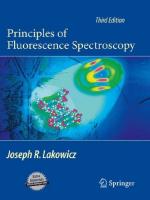|
This section contains 720 words (approx. 3 pages at 300 words per page) |

|
Fluorescence is the process by which a substance absorbs electromagnetic radiation (visible or invisible light) from another source, then re-emits the radiation with a wavelength that is longer than the wavelength of the illuminating radiation. It can be observed in gases at low pressure and in certain liquids and solids, such as the ruby gemstone. Fluorescence is the principle that is the basis of the common fluorescent lamp used for lighting; it is also a useful laboratory diagnostic tool.
Matter interacts with electromagnetic radiation (such as ultraviolet and visible light) through the processes of absorption and emission. The internal structure of atoms and molecules is such that absorption and emission of electromagnetic radiation can occur only between distinct energy levels. If the atom is in its lowest energy level or ground state, it must absorb the exact amount of energy required to reach one of its higher energy...
|
This section contains 720 words (approx. 3 pages at 300 words per page) |

|


